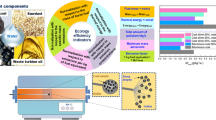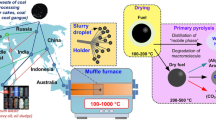Abstract
The utilization of waste from coal and petroleum extraction and processing is of critical importance today. Classical disposal methods, such as incineration or burial, are ineffective and environmentally harmful. The present work shows that the environmental impact of such waste may be reduced if it is used in fuels based on water suspensions. Mixtures containing oil slurries, filter cake from coking coal, and sawdust are considered. The concentration of sulfur and nitrogen oxides formed in combustion is determined. Various characteristics of the emissions from the fuels containing the waste are determined. The combustion of fuels containing these components in different proportions may decrease anthropogenic SO2 and NOx emissions by 4–48% and 16–39%, respectively.





Similar content being viewed by others
REFERENCES
Al-Mulali, U., Oil consumption, CO2 emission and economic growth in MENA countries, Energy, 2011, vol. 36, no. 10, pp. 6165–6171.
Kim, J.-H., Oh, J.-I., Baek, K., et al., Thermolysis of crude oil sludge using CO2 as reactive gas medium, Energy Convers. Manage., 2019, vol. 186, pp. 393–400.
Liu, H., Zhao, S., Xie, Z., et al., Investigation of the pyrophoric tendency of the powder of corrosion products in an oil tank, Powder Technol., 2018, vol. 339, pp. 296–305.
Klimenko, V.V. and Tereshin, A.G., World power engineering and global climate after the year 2100, Therm. Eng., 2010, vol. 57, pp. 1035–1041.
Gerasimov, A.M., Syroezhko, A.M., Itskovich, V.A., et al., Optimal component ratio in the thermochemical processing of fossil fuels with petroleum slurry, Coke Chem., 2012, vol. 55, pp. 350–352.
Nyashina, G.S., Vershinina, K.Y., and Strizhak, P.A., Impact of micro-explosive atomization of fuel droplets on relative performance indicators of their combustion, Fuel Process. Technol., 2020, vol. 201, art. ID 106334.
Cheng, S., Zhang, H., Chang, F., et al., Combustion behavior and thermochemical treatment scheme analysis of oil sludges and oil sludge semicokes, Energy, 2019, vol. 167, pp. 575–587.
Cheng, S., Chang, F., Zhang, F., et al., Progress in thermal analysis studies on the pyrolysis process of oil sludge, Thermochem. Acta, 2018, vol. 663, pp. 125–136.
Prashanth, P.F., Shravani, B., Vinu, R., et al., Production of diesel range hydrocarbons from crude oil sludge via microwave-assisted pyrolysis and catalytic upgradation, Process Saf. Environ. Prot., 2021, vol. 146, pp. 383–395.
Tian, K., Liu, W.J., Qian, T.T., et al., Investigation on the evolution of containing organic compounds during pyrolysis of sewage sludge, Environ. Sci. Technol., 2014, vol. 48, pp. 10888–10896.
Linak, W.P., McSorley, J.A., Hall, R.E., et al., Nitrous oxide emissions from fossil fuel combustion, J. Geophys. Res.: Atmos., 1990, vol. 95, pp. 7533–7541.
Kambara, S., Takarada, T., Toyoshima, M., and Kato, K., Relation between functional forms of coal nitrogen and NOx emissions from pulverized coal combustion, Fuel, 1995, vol. 72, pp. 1247–1253.
Wang, X., Ren, Q., Li, L., et al., TG-MS analysis of nitrogen transformation during combustion of biomass with municipal sewage sludge, J. Therm. Anal. Calorim., 2016, vol. 123, pp. 2061–2068.
Wang, Z., Gong, Z., Wang, Z., et al., A TG-MS study on the coupled pyrolysis and combustion of oil sludge, Thermochem. Acta, 2018, vol. 663, pp. 137–144.
Vetkin, A.V. and Suris, A.L., The formation of nitrogen oxides in the combustion chamber, Khim. Neftegaz. Mashinostr., 2013, no. 10, pp. 9–11.
Wei, X., Schnell, U., and Hein, K.R., Behavior of gaseous chlorine and alkali metals during biomass thermal utilization, Fuel, 2005, vol. 84, pp. 841–848.
Rudyka, V.I., Kravchenko, S.A., Abdullin, S.Yu., et al., Reduction of NOx release in the context of tightening of environmental standards at coking plants, Koks Khim., 2012, no. 5, pp. 32–38.
Wu, Z. and Ohtsuka, Y., Nitrogen distribution in a fixed bed pyrolysis of coals with different Ranks: formation and source of N2, Energy Fuel, 1997, vol. 11, pp. 477–482.
Kumar, A., Sah, B., Singh, A.R., et al., A review of multi criteria decision making (MCDM) towards sustainable renewable energy development, Renewable Sustainable Energy Rev., 2017, vol. 69, pp. 596–609.
Haddad, B., Liazid, A., and Ferreira, P., A multi-criteria approach to rank renewables for the Algerian electricity system, Renewable Energy, 2017, vol. 107, pp. 462–472.
Wimmler, C., Hejazi, G., de Oliveira Fernandes, E., et al., Multi-criteria decision support methods for renewable energy systems on islands, J. Clean Energy Technol., 2015, vol. 3, pp. 185–195.
Njuguna Matheri, A., Mbohwa, C., Ntuli, F., et al., Waste to energy bio-digester selection and design model for the organic fraction of municipal solid waste, Renewable Sustainable Energy Rev., 2018, vol. 82, pp. 1113–1121.
Nyashina, G.S., Kurgankina, M.A., and Strizhak, P.A., Environmental, economic and energetic benefits of using coal and oil processing waste instead of coal to produce the same amount of energy, Energy Convers. Manage., 2018, vol. 174, pp. 175–187.
Kuznetsov, G.V., Nyashina, G.S., Valiullin, T.R., and Martova, S.V., Benefits of slurry fuels based on industrial wastes, Coke Chem., 2019, vol. 62, pp. 422–432.
Funding
Financial support was provided by the Russian Foundation for Basic Research (project 18-43-700001).
Author information
Authors and Affiliations
Corresponding authors
Additional information
Translated by B. Gilbert
About this article
Cite this article
Ahmetshin, M.R., Nyashina, G.S. & Medvedev, V.V. Gas Emissions in the Combustion of Slurry Fuels Containing Petroleum Waste. Coke Chem. 64, 169–175 (2021). https://doi.org/10.3103/S1068364X21040025
Received:
Revised:
Accepted:
Published:
Issue Date:
DOI: https://doi.org/10.3103/S1068364X21040025




